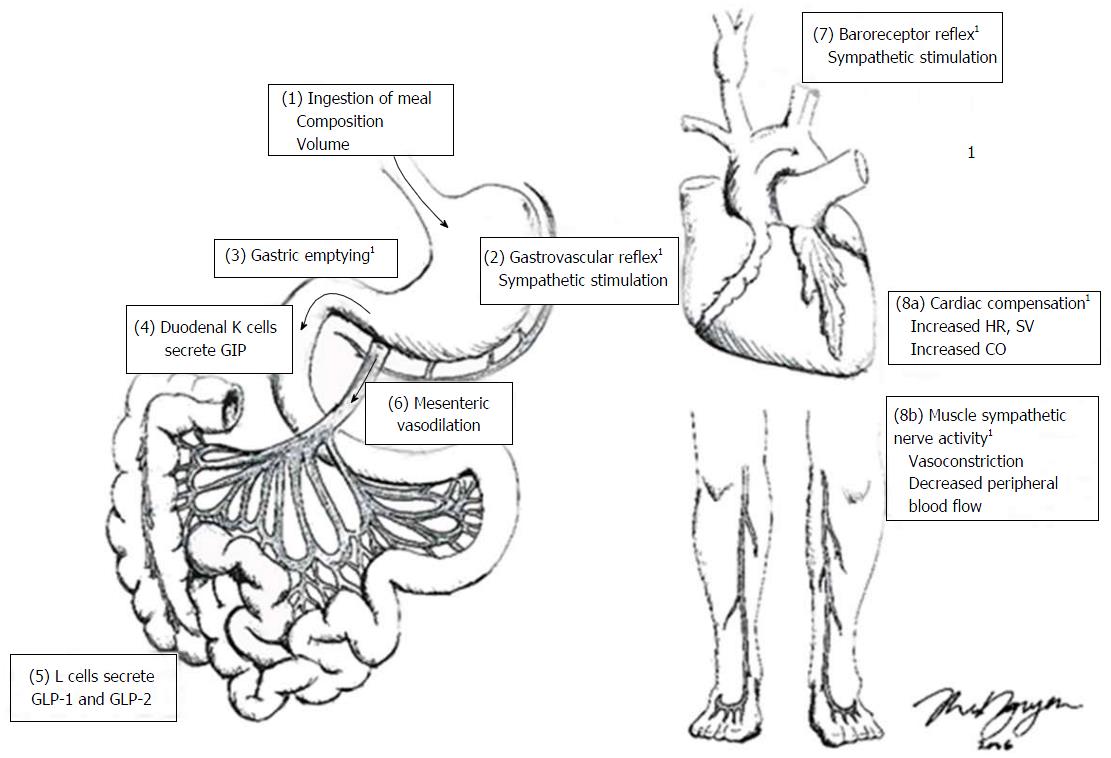 肠系膜的血流
肠系膜的血流
# 展示一些图片
- img: /img/WJCCM-6-28-g001.jpg # 图片地址
link: /pages/d5b89a/ # 链接地址
name: 肠系膜血流
desc: 肠系膜血管在进食后扩张,心率增快,每搏量增加,予以代偿。 # 可选
author: SSCC # 可选
avatar: https://xxx.jpg # 作者头像,可选
2
3
4
5
6

点击查看图片的中文说明
- 进食大量碳水化合物会导致显著的餐后低血压反应;
- 进餐导致胃扩张触发胃壁的牵张感受器,会增强交感神经的传出信号;(胃肠血管反射,交感刺激)
- 胃内容物排空进入小肠,并与小肠内的营养物质发生反应; 小肠分泌胃肠肽
- 十二指肠 K 细胞分泌葡萄糖促胰岛素多肽(GIP);
- L 细胞分泌胰高血糖素样肽(GLP-1 和 GLP-2);
- 胃肠肽刺激肠系膜血管扩张;
- 这导致循环血量减少和血压下降,可被压力感受器感知;(压力感受器反射,交感刺激)
- 胃肠血管和压力感受器反射刺激交感神经活性,增加心率和每搏量,从而增加心输出量,维持餐后血压;
- 骨骼系统血管收缩,导致外周血流量下降;
- 这些因素受年龄影响。
点击查看图片的英文说明
Figure 1 Factors involved in the regulation of postprandial blood pressure. (1) ingestion of a meal, with a greater carbohydrate load results in a greater postprandial hypotensive response; (2) Meal-induced gastric distension from the meal triggers stretch receptors in the stomach wall, increasing sympathetic nerve outflow; (3) gastric content is emptied into the small intestine, and, in response to the nutrient in the small intestine; (4, 5) gastrointestinal peptides are secreted from the small intestine (e.g., GLP-1 and GLP-2, glucagon-like peptide-1 and 2; GIP, glucose insulinotropic polypeptide); (6) gastrointestinal peptides stimulate mesenteric vessel dilation; (7) this results in reduced circulating blood volume and the reduction in blood pressure is detected by baroreceptors; (8a) the “gastrovascular” and baroreceptor reflexes stimulate sympathetic activity to increase heart rate (HR), stroke volume (SV) and thus cardiac output (CO) to maintain postprandial blood pressure; (8b) skeletal vasculature constricts to decrease peripheral blood flow. 1These factors are affected by age and have been identified as potential pathophysiological mechanisms of postprandial hypotension. Figure drawn by Ms. T. Nguyen. GIP: Glucose-dependent insulinotropic peptide; GLP: Glucagon-like peptide.

